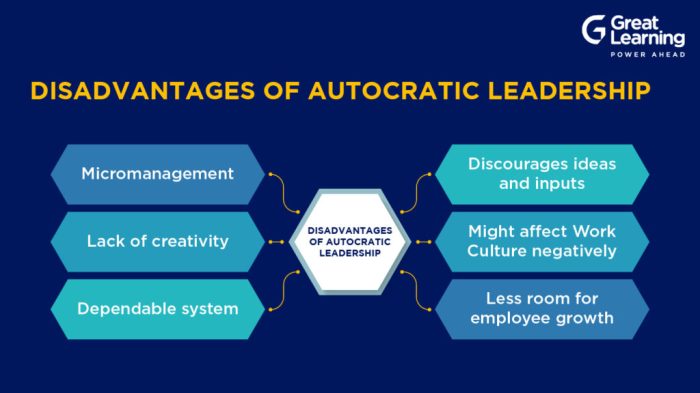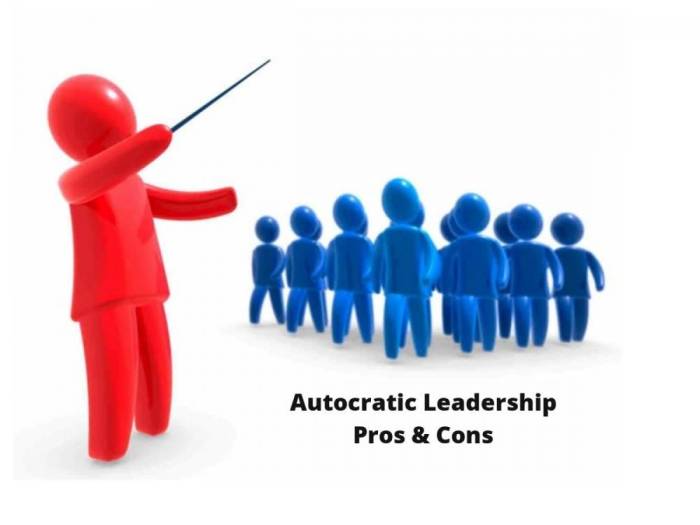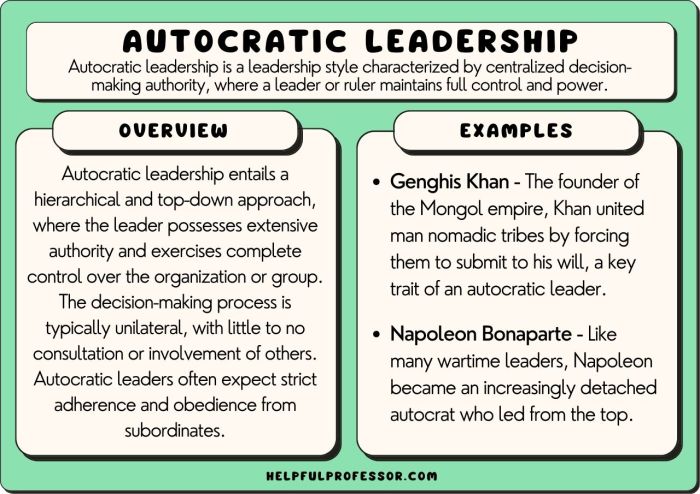Autocratic leadership tends to be the best option when decisive action is paramount and efficiency is non-negotiable. This leadership style, characterized by centralized authority and limited employee input, offers distinct advantages in specific scenarios.
In times of crisis, autocratic leaders can make swift decisions, ensuring a unified and rapid response. They provide clear direction and eliminate the potential for delays caused by consensus-building. Moreover, in highly specialized fields where expertise is concentrated in a few individuals, autocratic leadership can harness that expertise effectively.
Autocratic Leadership: Advantages and Disadvantages

Autocratic leadership is a style of leadership in which one person has absolute power and authority. This type of leadership is often seen in organizations with a clear hierarchy, such as the military or large corporations. Autocratic leaders make all the decisions and do not consult with others before acting.
This can be an effective style of leadership in situations where quick decision-making is crucial, but it can also be stifling to creativity and innovation.
Advantages of Autocratic Leadership in Specific Situations
Autocratic leadership can be an effective style of leadership in situations where quick decision-making is crucial. For example, in a military setting, an autocratic leader can make decisions quickly and efficiently without having to consult with others. This can be essential in situations where the lives of soldiers are at stake.
Autocratic leadership can also be effective in situations where there is a need for clear direction and accountability. For example, in a large corporation, an autocratic leader can set clear goals and objectives for the organization and hold employees accountable for meeting those goals.
Disadvantages of Autocratic Leadership in General

Autocratic leadership can also have some disadvantages. One of the biggest disadvantages is that it can stifle creativity and innovation. When employees are not given the opportunity to share their ideas, they may be less likely to come up with new and innovative solutions to problems.
Another disadvantage of autocratic leadership is that it can lead to low employee morale. When employees feel like they have no say in the decisions that are made, they may become less motivated and less productive.
When Autocratic Leadership May Be Appropriate: Autocratic Leadership Tends To Be The Best Option When
Autocratic leadership may be appropriate in situations where there is a need for quick decision-making, clear direction, and accountability. For example, autocratic leadership may be effective in the following situations:
- In a military setting
- In a large corporation
- In a crisis situation
Comparison of Autocratic and Other Leadership Styles
Autocratic leadership is one of several different leadership styles. Other leadership styles include democratic leadership, laissez-faire leadership, and transactional leadership.
The following table compares autocratic leadership to other leadership styles:
| Leadership Style | Decision-Making Process | Employee Involvement | Potential Outcomes |
|---|---|---|---|
| Autocratic | Leader makes all decisions | Low | Quick decision-making, clear direction, low employee morale |
| Democratic | Leader consults with employees before making decisions | High | Employee buy-in, high morale, slow decision-making |
| Laissez-faire | Leader gives employees complete autonomy | Low | Employee empowerment, creativity, lack of direction |
| Transactional | Leader rewards employees for good performance | Medium | Employee motivation, clear expectations, lack of creativity |
Ethical Considerations of Autocratic Leadership

Autocratic leadership can raise some ethical concerns. One of the biggest concerns is that autocratic leaders may abuse their power. This can lead to employees being treated unfairly or even being exploited.
Another ethical concern is that autocratic leaders may not be transparent about their decision-making process. This can make it difficult for employees to understand why decisions are being made and how they can contribute to the organization.
Case Studies of Autocratic Leadership

There are many examples of successful and unsuccessful autocratic leaders throughout history. Some of the most successful autocratic leaders include Alexander the Great, Julius Caesar, and Napoleon Bonaparte. These leaders were able to achieve great things because they were able to make quick decisions, set clear goals, and hold people accountable.
However, there are also many examples of unsuccessful autocratic leaders. Some of the most notorious autocratic leaders include Adolf Hitler, Joseph Stalin, and Mao Zedong. These leaders were able to achieve great power, but they also caused great suffering and destruction.
Expert Answers
What are the key advantages of autocratic leadership?
Autocratic leadership offers advantages such as rapid decision-making, clear direction, and the ability to leverage specialized expertise.
When is autocratic leadership most appropriate?
Autocratic leadership is most appropriate in situations requiring decisive action, efficiency, and specialized expertise, such as crisis management and highly specialized fields.
What are the ethical concerns associated with autocratic leadership?
Autocratic leadership raises ethical concerns regarding the potential for power abuse and the suppression of employee input. It is essential to implement accountability and transparency mechanisms to mitigate these concerns.